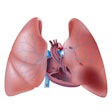Thursday, December 3 | 11:00 a.m.-11:10 a.m. | SSQ20-04 | Room S404AB
In an international tour de force on computer-aided detection (CAD), Dutch researchers took an automated calcium scoring algorithm designed for a European lung cancer screening study and applied it to a Canadian screening study.Previous research has shown that it pays to look for coronary artery calcifications in thoracic imaging studies, even though they are ungated, to identify individuals with a high risk of a cardiovascular event.
The algorithm worked smoothly to gauge coronary artery disease risk in all of the subjects in the Pan-Canadian Early Detection of Lung Cancer Study (PanCan), according to Nikolas Lessmann from University Medical Center Utrecht in the Netherlands.
"We found that lung cancer screening CT scans can be fully automatically analyzed for coronary calcifications to identify subjects at high risk for cardiovascular events, without requiring additional imaging or reading time," Lessmann told AuntMinnie.com. "An interesting aspect is that we used an algorithm developed and trained for the scanning protocol of a different trial, but still achieved good agreement with manual calcium scores."
The technique could boost the cost-effectiveness of CT lung cancer screening as well, Lessmann added.



















